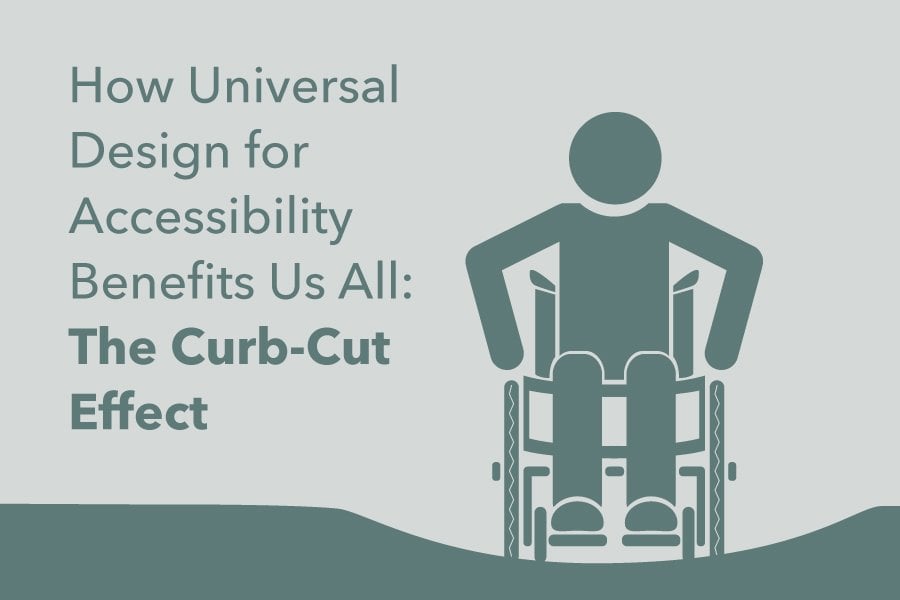3 min read
How Universal Design for Accessibility Benefits Us All: The Curb-Cut Effect
Shae Bouchard : October 25, 2022

In the 1970s, a group of wheelchair users in Berkeley, CA became frustrated by the obstacles created by sidewalks. Taking matters into their own hands, they created a makeshift ramp to safely roll up and down the curb. Two years later, thanks to the advocacy of disabled activists, the City of Berkeley installed its first official curb cut. It was a wonderfully simple solution to a dire need, and one that led to similar changes in cities across the country.
What is the Curb-Cut Effect?
The “curb cut effect” is a perfect example of universal design - the concept of designing spaces and products that are usable by the greatest number of people. The goal is to create designs that are flexible, simple, and intuitive to use by people of all abilities. Curb cuts in sidewalks were originally intended to make community mobility more accessible for wheelchair users. However, it became obvious they are also helpful for people with balance or strength deficits, parents pushing strollers, travelers wheeling luggage, bikers, runners… the list goes on! The “curb cut effect” is when something is designed specifically for one need, but ends up benefiting the community as a whole. Think of closed captioning, speech-to-text technology, audiobooks, electric toothbrushes… all were created to improve accessibility, but many of us who are able-bodied use them every day.
The Curb-Cut Effect in Action
There are many companies (including WheelPad) who are taking the “curb-cut effect” to heart and designing products that are easier to use for everyone. For example, as a physical therapist, I find that the seemingly simple task of getting dressed is a common source of frustration for my patients. For someone with mobility or cognitive impairments, this can be a laborious task even with the help of a care partner. Dressing using typical clothing can be difficult, time consuming, and exhausting, and the clothing itself may be uncomfortable or restrictive.
Through my work as a physical therapist, I have discovered that Nike® products include a variety of sneakers with different types of closures for adults and kids, making it simple for people using braces or prosthetic legs, people with limited dexterity, or people who just prefer a different style. The Nike FlyEase sneaker with wraparound zipper works really well for people who wear ankle braces or require a non-laced shoe.
One patient, a former athlete in his 40s who experienced a traumatic brain injury, had poor fine motor control and a visual impairment on his left side. He was mostly independent with his clothing, but struggled with tying his shoes. For a man used to stylish athletic wear, Velcro straps or elastic laces were out of the question and the slippers he used in the hospital weren’t going to work for community living. The solution? Magnetic shoe closures called Zubits! This device laces right into regular shoelaces, so he could keep wearing his favorite sneakers. He could now create a wide opening in the shoe for easy donning and then connect the magnets with one hand for a quick and secure fit. At the end of the day, he could easily take his shoes off hands-free by stepping on the heel of his shoe. This simple device was a game-changer for him, but could certainly be used by anyone – children, bikers looking to avoid loose laces, travelers who want to store their shoes together, or someone simply wanting a “bowless” look.
Adaptive Clothing
I also work with many patients who use wheelchairs. Our top priority is preventing skin breakdown (pressure ulcers or pressure injuries). These can occur when there is prolonged pressure over an area of skin resulting in reduced blood flow, often over the tailbone or buttocks – think about sitting in the same position for an hour or two, without the ability to shift or stand up. IZ Adaptive and Seven7 are two companies that design clothes with seamless back pants to prevent areas of increased pressure, and therefore reduce the risk of dangerous wounds. Their designs also include a variety of closure options (buttons, magnets, zippers), stretch fabric, accessible pockets, and extended fly zippers that allow for improved accessibility for anyone that struggles with traditional clothing.
These are just a few examples of companies that are realizing the benefit of universal design. I am hopeful that we will see more inclusivity in the products from larger companies who can offer creative products to make daily living and dressing simple, stylish, and comfortable for all!